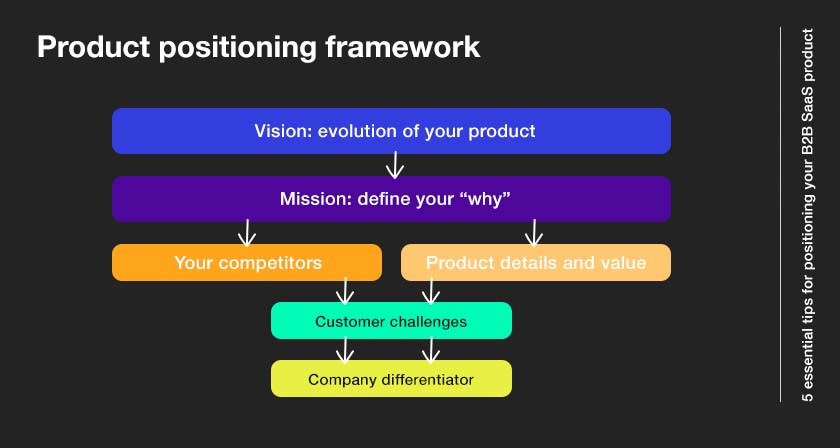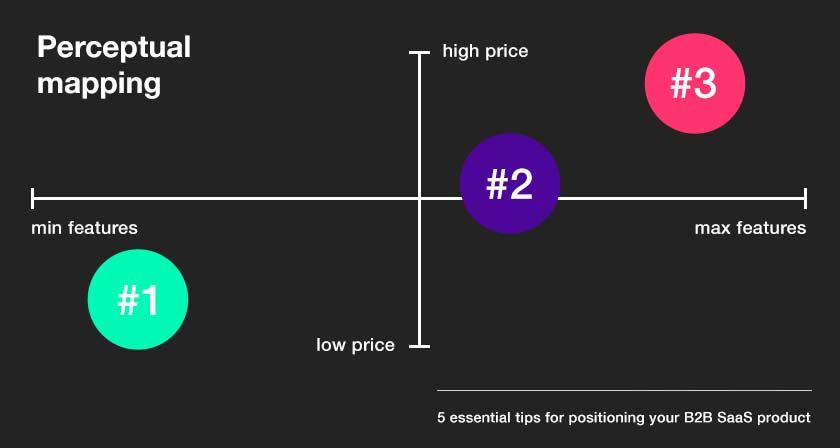
5 essential tips for positioning your SaaS product
What you need to know about product positioning and what it can do for your company.
Positioning is an essential element of product marketing – yet it’s also one of the most challenging to get right. Overall, positioning helps companies, SaaS or otherwise, stand out in the eyes of potential customers. This is especially important when there are many alternatives on the market. However, it’s a continuous process that involves many steps.
This article shares 5 essential recommendations that all marketers should consider when positioning their product.
The ultimate goal of product positioning
Positioning can be a bit of an elusive concept, as marketers and researchers have different interpretationsof what it means. Still, key themes emerge from the many definitions. Philip Kotler, renowned as the ‘father of modern marketing’, captures the overall gist in one sentence:
Positioning is the act of designing the company’s offering and image so that they occupy a meaningful and distinct competitive position in the mind of the target market.
Essentially, the ultimate goal is to firmly establish your product in your customers’ minds so that they’re able to imagine future situations where they might buy from you. When these situations actually happen, your product would be a part of their ‘evoked set’ – a cognitive term used to describe the brands that come to people’s minds whenever a particular need arises.
Why it’s important to get your positioning correct
Positioning is already essential for most businesses – after all, when customers are looking to purchase something, they are always looking for the ‘best fit’ for them at that moment. In most cases, your product will be competing against many others. This makes positioning important as it helps your offering stand out to the most relevant people. Without it, your sales cycles become more long-winded and you risk a higher customer churn rate.
However, it’s especially important that SaaS companies position their products effectively. This is because software often shares the same features, since it’s usually difficult and time-consuming to patent software. Also, unlike tangible B2C consumables, software is considered more abstract and difficult for people to quickly compare. This means marketers should spend extra effort establishing a clear product position.

Tips for positioning your SaaS product
Get your segmentation and targeting right first
According to the tried-and-true STP process, positioning must come after segmentation and targeting. So before you consider ways to effectively position your B2B software, make sure that you have a clear understanding of the various segments in the market – and the ones you want to focus on. Otherwise, your positioning may not be as effective.
Consider the different variables. Most B2B companies use simple factors such as company size and industry type, but marketers may also explore behavioural and needs-based segmentation (if they have available data). You should also select segments to target based on two things: how lucrative the segment is and your company’s competitive strengths.
If you have enough organisational resources to meet the needs of a fast-growing and sizeable market segment, then they should be your primary target.

Decide your product positioning strategies carefully
Positioning strategies refer to the ways you’ll compete in a particular market. This informs all your marketing mix decisions (product, price, place, and promotion).
Every strategy has its advantages and disadvantages. Some businesses focus on just one, but many use a combination of strategies to minimise risk. It’s important that your combination makes sense, or you’ll risk confusing your customers (more on that later).
Below are some of the most relevant positioning strategies for SaaS products.
Quality
Positioning your offering as a superior, higher-quality alternative to your competitors’ products could be a suitable strategy – if your target market is discerning, demanding, and relatively price-insensitive. This approach requires effective quality assessment and assurance processes (through technical reviews, code testing, etc.), which ensures that your claims of quality are believable. Naturally, you should also focus on raising your company image and reputation.
Pricing
All businesses aim to keep costs as low as possible, but some choose to make price a part of their positioning strategy. This can be very effective for companies that serve particularly price-sensitive market segments (such as SMEs).
However, positioning your product as cheap software carries some risks. Firstly, you may not be able to scale as quickly if you focus only on keeping costs as low as possible. Secondly, it may hinder you from building a sustainable competitive advantage. This is because you may become vulnerable to new competitors entering the market with more innovative offerings.
Innovation
When markets are changing because of technological advancements, there may be a good opportunity to position your SaaS product based on innovativeness. To maximise your chances of success, your target market should be adventurous early adopters by nature. New product development and market identification should also be a strength in your organisation.
Benefits
A powerful and popular way to position your product is to highlight the unique benefits it provides and how it directly solves your customers’ problems. You may have noticed some companies positioning themselves as a ‘solutions provider’. In order to succeed with this approach, you should segment customers based on the benefits they’re seeking (instead of basic demographic characteristics).
Be careful of major positioning risks
Good positioning is clear, believable, and has an appropriate level of focus. Once your target customers become aware of your offering, they will compare it to other alternatives based on relevant criteria. Once this has happened, it can be difficult to change their minds. Therefore, it’s key that you prevent the following:
Under-positioning
When your target customers are aware of your product, but don’t see anything special about it, you’ve under-positioned your software. Other signs of under-positioning may include inconsistent sales volumes and a lack of leads. To overcome this, you may need to audit your marketing activities and identify opportunities to communicate your USP more concisely.
Over-positioning
Over-positioning is when customers have an overly narrow understanding of your software or your company. For example, you may have focused on a feature or benefit that your target segment is only mildly interested in – this limits your sales potential. Broaden your messaging to make sure potential customers have a fuller perception of what you offer.
Confused positioning
If the messages you’re sending change frequently (or if they’re contradictory), you risk confusing customers. Companies going through a rebranding or repositioning process should be especially careful.
Doubtful positioning
There are situations where the buyer is aware of what your software does but doesn’t believe the claims you made. This is called doubtful positioning, and can be challenging to overcome. You may prevent this from happening by choosing the right positioning strategies.

Create perceptual maps to effectively visualise market gaps
Perceptual mapping is a technique product marketers use to better understand how products in a relevant category ‘fit’ in the minds of target customers. It can help you check whether your current positioning strategy is working. What’s more, it lets you identify and visualise market gaps easier.
A common mistake when creating perceptual maps is to visualise the products’ positions according to your own beliefs. This should be avoided. Instead, you should position them based on how customers themselves see existing solutions in the marketplace. Even though perceptual mapping is a qualitative exercise, you should use customer data to guide you.
Generally, perceptual maps are represented as plot graphs with four quadrants. How the y and x axes should be labelled depends on what is most relevant for your customers. If you offer a SaaS product, for example, you may position products according to ‘features’ and ‘price’.
Craft a strong positioning statement
Positioning statements serve as a useful anchor when you’re marketing your product. It provides direction to all your marketing activities and ensures that your team knows how to communicate value to your customers. By aligning your efforts, you prevent the risk of confused positioning.
One way to create a positioning statement is to provide answers to the following:
- Who you help: declaring your ideal target segment is key because it allows you to focus your attention on who matters the most.
- What your product does: be clear about the solution your offering provides and how it fulfills your customers’ needs – this allows them to categorise it in their minds.
- What differentiates your offering: make it easy for customers to remember how and why you’re unique.
On top of this, it’s recommended that you include how you help your customers deliver value to their own customers. Ask yourself how your customers’ businesses can continue to exist (and thrive) just by using your product. If your claims are credible and can be easily understood by your relevant stakeholders, then you’ve got a strong positioning statement that you can use to inform all your marketing assets.
Key takeaways
- The ultimate goal of product positioning is to establish your product firmly in your customers’ minds, which is especially important if you’re competing against others on the market.
- Before you consider positioning, make sure you’re satisfied with your segmentation and targeting strategy first.
- There are many positioning strategies you can choose. This will depend on how you want your customers (existing and potential) to perceive your product.
- There are four risks you should be mindful of: under-positioning, over-positioning, doubtful positioning and confused positioning.
- Perceptual maps can help you visualise market gaps and check if your current strategy is working. Use data to guide you when creating them.
- Crafting a strong positioning statement requires you to ask four questions: who you help, what your product does, what makes it different, and how it can help your customers’ businesses.
Read the latest positioning trends and insights.
Tap into our brand and product positioning, storytelling, and creative expertise to inspire your next strategic move.

